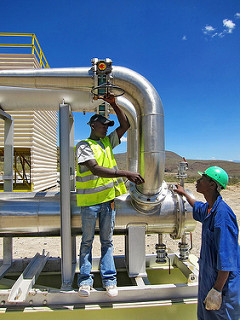LEDS in Practice: Ensure energy security to realize the benefits of low emission development

Introduction
Energy for power, heat, cooling, and mobility is the key ingredient for development and growth. In recent years, energy security has regained interest because of ever increasing demand for energy, aspirations on providing energy access for all, worries about global scarcity of fossil fuels, and environmental concerns related to fossil fuel use.
Scaling up renewable energy as part of a low emission development strategy typically diversifies countries’ energy mixes and reduces dependence on imports. It lowers geopolitical risks and exposure to fuel price volatility, and improves the balance of trade for importing countries (noting that only a handful of countries export oil and gas). Renewable energy offers lower financial and economic risk for businesses through a more stable and predictable cost base for energy supply.
This publication*, which was produced in partnership with the Energy research Centre of the Netherlands (ECN), explores how energy security goals can contribute to low emission development and how energy security goals can be integrated into low emission policies and planning. It also presents a short case study on energy security in Thailand’s Intended Nationally Determined Contribution (INDC) submitted to the UNFCCC.
*download the full report form the right-hand column. The key messages from the report are provided below – see the full text for more detail and further resources.
Key Messages
-
Energy security is a prerequisite for development and economic growth, and is arguably the most important driver for energy policy.
-
Low emission energy systems have the potential to greatly improve energy security; at the same time policies for reducing emissions often align or overlap with energy security policies.
-
Introduction of large shares of renewable energy into a country’s energy mix requires careful planning. Low emission development strategies can set pace and timing to ensure and improve energy security.
-
Energy efficiency and conservation present a double win situation in most (if not all) situations—lower demand both makes it easier to offer secure energy supply and reduces emissions from (fossil) power generation or fuel consumption.
Resilience and energy security—a win–win?
– By Sadie Cox, National Renewable Energy Laboratory (NREL)
Climate related temperature changes, droughts, and increases in extreme weather events have various implications for the energy sector. Rising temperatures are expected to increase energy demand, while decreased water availability and natural disasters may impact energy production and reliability of the electricity grid. Solutions for climate resilient, low emission energy systems include:
Deploying renewable energy sources adapted to climate change: Solar photovoltaic and wind power generation consume significantly less water than traditional thermal technologies and offer a valuable solution to address both climate change mitigation and resilience challenges.
Spatially diverse electricity systems: Whereas conventional power systems in one central geographic location could be severely impacted by a single weather event, spatially diverse electricity systems reduce the risk of large scale power outage where electricity is drawn from spatially distributed resources, including renewable energy. “Extreme weather events such as storms, forest fires, landslides, floods and extreme temperatures affect energy production and delivery facilities, cause supply disruptions and affect infrastructure that depends on the energy supply. The risk to energy infrastructure will grow as the frequency and intensity of certain types of extreme weather events increase.” Rising sea levels caused by climate change will affect coastal and offshore energy infrastructure, and need to be taken into account when choosing energy supply options.
Distributed generation such as micro grids or islanded systems: Systems that can operate independently from the central grid can be crucial during natural disasters or electricity outages to provide power to healthcare and other sensitive facilities.
This paper is one of LEDS GP’s ‘LEDS in Practice’ series, from their Benefits Working Group, which presents the benefits of LEDS for resilience, trade, employment, health, energy security, industrial competitiveness, and gender equality.
The case studies were developed in cooperation with Conservation International, the International Centre for Trade and Sustainable Development (ICTSD), the International Labour Organization (ILO), the Energy research Centre of the Netherlands (ECN), the United Nations Industrial Development Organization (UNIDO) and the International Union for Conservation of Nature (IUCN), respectively.
Each factsheet highlights opportunities and challenges, and includes policy recommendations and lessons learned from case studies, as well as an overview of tools to assess and integrate benefits into LEDS and Nationally Determined Contributions (NDCs).
Find the other case studies here:
- Promote gender equality
- Boost ecosystem resilience
- Use trade policy
- Create green jobs
- Gain the competitive edge
This series complements another set of ‘LEDS in Practice’ publications from our LEDS GP Transport Working Group, which highlight the social and economic benefits of low carbon urban transport (find out more here):
(0) Comments
There is no content